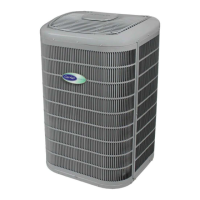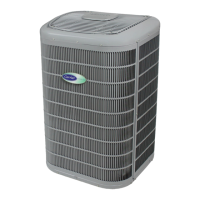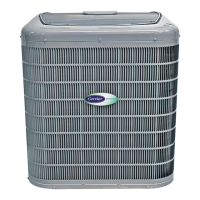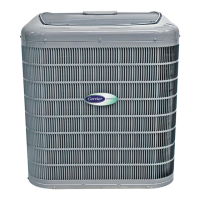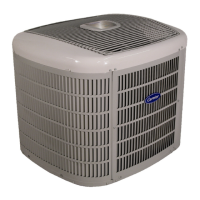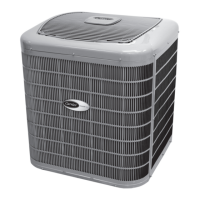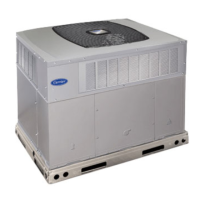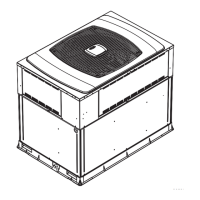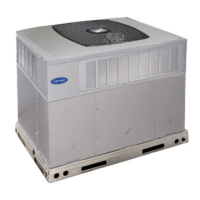24VNA6: Installation Instructions
Manufacturer reserves the right to change, at any time, specifications and designs without notice and without obligations.
6
Outdoor Unit Connected to Factory-Approved Indoor
Unit
Outdoor unit contains correct system refrigerant charge for operation
with factory-approved, AHRI-rated smallest indoor unit when
connected by 15 ft. (4.57 m) of field-supplied or factory-accessory
tubing, and factory-supplied filter drier. Check refrigerant charge for
maximum efficiency.
NOTE: If the indoor furnace coil width is more than the furnace casing
width, refer to the indoor coil Installation Instructions for transition
requirements.
Install Liquid-Line Filter Drier Indoor
Refer to Fig. 6 and install filter drier as follows on 24, 36 and 48 size
models:
1. Braze 5-in. (127 mm) liquid tube to the indoor coil.
2. Wrap filter drier with damp cloth.
3. Braze filter drier to above 5-in. (127 mm) liquid tube.
4. Connect and braze liquid refrigerant tube to the filter drier.
Refer to Fig. 7 and install filter drier as follows on 60 size models:
1. After wrapping the liquid service valve with a wet cloth braze 5-in.
(127 mm) liquid tube to the liquid service valve on outdoor unit.
2. Wrap filter drier with damp cloth.
3. Braze filter drier to above 5-in. (127 mm) liquid tube.
4. Connect and braze liquid refrigerant tube to the filter drier.
A05178
Fig. 6 – Liquid-Line Filter Drier for 2, 3 & 4 Ton Applications
A200059
Fig. 7 – Liquid-Line Filter Drier for 5 Ton Applications
Refrigerant Tubing connection Outdoor
Connect vapor tube to fitting on outdoor unit vapor service valves (see
Table 1).
Sweat Connections
Use refrigerant grade tubing. Service valves are closed from factory and
ready for brazing. After wrapping service valve with a wet cloth, braze
sweat connections using industry accepted methods and materials.
Consult local code requirements. Refrigerant tubing and indoor coil are
now ready for leak testing. This check should include all field and
factory joints.
Evacuate Refrigerant Tubing and Indoor Coil
Refrigerant tubes and indoor coil should be evacuated using the
recommended deep vacuum method of 500 microns. The alternate triple
evacuation method may be used. See Service Manual for triple
evacuation method. Always break a vacuum with dry nitrogen prior to
opening the refrigerant system for servicing.
Deep Vacuum Method
The deep vacuum method requires a vacuum pump capable of pulling a
vacuum of 500 microns and a vacuum gauge capable of accurately
measuring this vacuum depth. The deep vacuum method is the most
positive way of assuring a system is free of air and liquid water. (See
Fig. 8)
A95424
Fig. 8 – Deep Vacuum Graph
CAUTION
!
UNIT DAMAGE HAZARD
Failure to follow this caution may result in unit damage or improper
operation.
Installation of filter drier in liquid line is required.
EXTERIOR
WALL
LIQUID LINE
FILTER DRIER
TO DWELLING
CAUTION
!
UNIT DAMAGE HAZARD
Failure to follow this caution may result in equipment damage or
improper operation.
• Use a brazing shield
• Wrap service valves with wet cloth or heat sink material.
CAUTION
!
UNIT DAMAGE HAZARD
Failure to follow this caution may result in equipment damage or
improper operation.
Never use the system compressor as a vacuum pump.
500
MINUTES
01234567
1000
1500
LEAK IN
SYSTEM
VACUUM TIGH
TOO WET
TIGHT
DRY SYSTEM
2000
MICRONS
2500
3000
3500
4000
4500
5000

